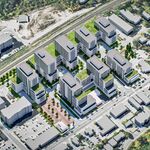I wouldn't necessarily be surprised if Transit City came back, although I wouldn't want a 100% return to the previous plan. My hope would be that the following changes would be implemented:
1) That Metrolinx would assume full control of the planning and design process. The TTC has shown that it is too politically driven and has too narrow of a mindset when it comes to designing the lines (i.e. "in-median at-grade LRT unless it absolutely can't be done").
2) That the SLRT and ECLRT remain one continuous through-line, instead of having the SLRT end at Kennedy like in the original Transit City plan. Keeping a linear transfer when you have the opportunity to remove it is just bone-headed.
3) Don't bring back the SELRT. Use the $300 million in federal money to improve the bus service along Sheppard (dedicated lanes in congested areas, queue jump lanes in others, etc). Take the other $600 million in Provincial funds and put them to better use someplace else. 3,100 peak hour in 2031 isn't worthy of LRT.
4) Use the $600 million from Sheppard East to complete the entire FWLRT, from Yonge to Humber College.
5) Figure out a solution that actually works for Eglinton East. Tunnelling is too expensive, but if you're running the ECLRT and SLRT as a single line, at-grade isn't going to be able to handle the demand. Trench it, elevate it, have it at-grade between intersections but dip down underneath major intersections (have the at-grade sections actually be 1m or so below grade if you're worried about the roller coaster effect). This is where the Metrolinx lead comes in, because they will hopefully be able to come up with some workable solutions that the TTC wouldn't consider.
Transit City had some good elements, and it had some not-so-good elements. A lot of those not-so-good elements were the result of the insistence on the part of Miller & Co that all Transit City lines be in-median LRT unless not possible. This lead to some design choices in some areas where another configuration would have been much more efficient (the Golden Mile and Eglinton & Leslie come to mind). Hopefully will less political interference in play (because let's face it, if Transit City is re-instated, Rob Ford's say on transit issues is completely muted), some design changes can be implemented that will make the lines more efficient.








